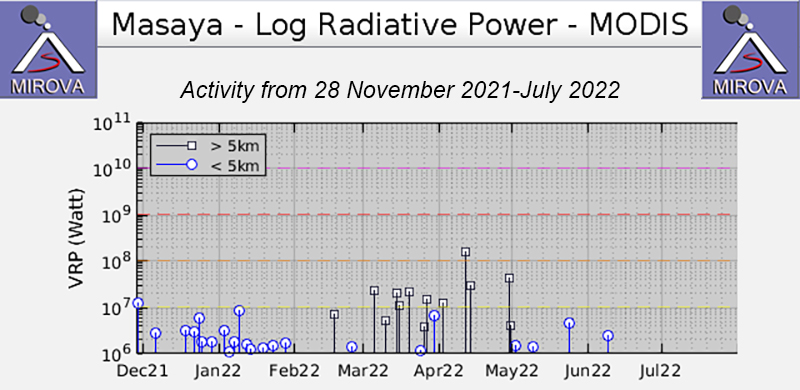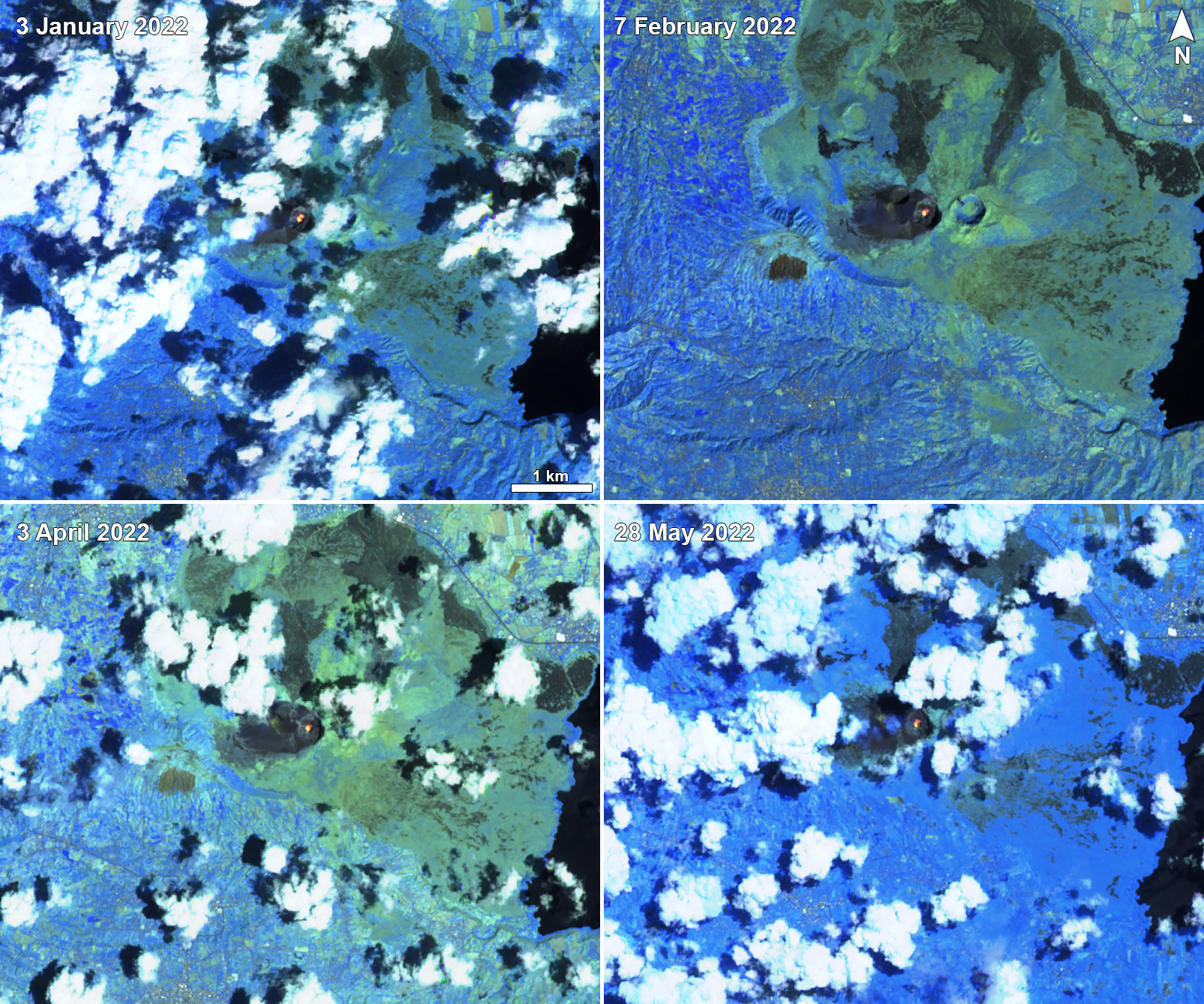Report on Masaya (Nicaragua) — August 2022
Bulletin of the Global Volcanism Network, vol. 47, no. 8 (August 2022)
Managing Editor: Benjamin Andrews.
Edited by Kadie L. Bennis.
Masaya (Nicaragua) Weak thermal anomalies and gas-and-steam emissions during January-July 2022
Please cite this report as:
Global Volcanism Program, 2022. Report on Masaya (Nicaragua) (Bennis, K.L., and Andrews, B., eds.). Bulletin of the Global Volcanism Network, 47:8. Smithsonian Institution.
Masaya
Nicaragua
11.9844°N, 86.1688°W; summit elev. 594 m
All times are local (unless otherwise noted)
Masaya comprises a 6.5 x 11.5 km caldera consisting of the Nindirí, San Pedro, San Juan, and Santiago craters. The Santiago crater is currently the most active and contains a small lava lake that emits weak gas-and-steam plumes. It is located about 20 km SE of Managua, the capital of Nicaragua. The current eruption period began in October 2015 and has more recently consisted of an active lava lake and gas-and-steam emissions (BGVN 47:01). This report covers activity during January through July 2022, characterized by weak thermal activity in the lava lake, gas-and-steam emissions, and seismicity based on Instituto Nicaragüense de Estudios Territoriales (INETER) monthly reports and satellite data.
MIROVA (Middle InfraRed Observation of Volcanic Activity) analysis of MODIS satellite data showed nine low-power thermal anomalies during January 2022, which then decreased to one anomaly in late February, two in March, three in May, and one in June (figure 104). A weak hotspot was also reflected in Sentinel-2 infrared satellite images during January through July in the Santiago crater’s lava lake (figure 105). Few weak sulfur dioxide plumes drifted generally W during mid-January, late April, and May, based on data from the TROPOMI instrument on the Sentinel-5P satellite.
Activity was relatively low throughout the reporting period. Seismic tremor continued to be detected, varying between 80-100 RSAM units; roughly 21,352 seismic events, some of which were low frequency (LF), were recorded between January and July 2022, the most of which occurred in April (6,637). On 7 February, INETER measured the temperature of the Santiago crater, in addition to taking thermal images and Multigas measurements. Landslides and erosion were also recorded on the internal walls of the crater and lava lake, accompanied by white gas-and-steam emissions. The maximum temperature was 904.3°C, which INETER reported was higher than previous months, based on data from FLIR (forward-looking infrared) images. Sulfur dioxide measurements made during March were an average of 1,001 tons/day (t/d), based on data from several transects using a mobile DOAS spectrometer, which was lower than the measurements taken during February (1,844 tons/day). On 2 March INETER observed that the lava lake level had decreased, which obscured clear views. The temperature of the lava lake remained between the typical range of 500-800°C. During April the sulfur dioxide emissions measured 1,206 t/d, which had increased slightly from the previous month.
During 2-18 May a seismic swarm occurred in the Ticuantepe, which is located to the NW of the Santiago crater (figure 106). There were 43 earthquakes that were detected and on 10 May, a strong Mw 3.5 earthquake was felt by the entire population of Ticuantepe, some in Masaya, and some in Managua. The typical range of the magnitude of these earthquakes was 1.1-3.5 with a depth ranging 4-7 km. On 25 May at 1258 an Mw 5.2 earthquake was detected at a depth of 24 km, located 102 km SW of Managua. On 10 May temperature measurements made in the Santiago crater were 657°C and there was subsidence of about 2 m. The volume of sulfur dioxide emissions continued to decrease to an average of 661 t/d during June.
Geological Summary. Masaya volcano in Nicaragua has erupted frequently since the time of the Spanish Conquistadors, when an active lava lake prompted attempts to extract the volcano's molten "gold" until it was found to be basalt rock upon cooling. It lies within the massive Pleistocene Las Sierras caldera and is itself a broad, 6 x 11 km basaltic caldera with steep-sided walls up to 300 m high. The caldera is filled on its NW end by more than a dozen vents that erupted along a circular, 4-km-diameter fracture system. The Nindirí and Masaya cones, the source of observed eruptions, were constructed at the southern end of the fracture system and contain multiple summit craters, including the currently active Santiago crater. A major basaltic Plinian tephra erupted from Masaya about 6,500 years ago. Recent lava flows cover much of the caldera floor and there is a lake at the far eastern end. A lava flow from the 1670 eruption overtopped the north caldera rim. Periods of long-term vigorous gas emission at roughly quarter-century intervals have caused health hazards and crop damage.
Information Contacts: Instituto Nicaragüense de Estudios Territoriales (INETER), Apartado Postal 2110, Managua, Nicaragua (URL: http://www.ineter.gob.ni/); MIROVA (Middle InfraRed Observation of Volcanic Activity), a collaborative project between the Universities of Turin and Florence (Italy) supported by the Centre for Volcanic Risk of the Italian Civil Protection Department (URL: http://www.mirovaweb.it/); NASA Global Sulfur Dioxide Monitoring Page, Atmospheric Chemistry and Dynamics Laboratory, NASA Goddard Space Flight Center (NASA/GSFC), 8800 Greenbelt Road, Goddard, Maryland, USA (URL: https://so2.gsfc.nasa.gov/); Sentinel Hub Playground (URL: https://www.sentinel-hub.com/explore/sentinel-playground).




